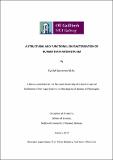| dc.description.abstract | This thesis encompasses two aims, firstly, to describe the normal anatomy of human
term myometrium, as this is not fully characterised in the literature, and secondly, to
assess whether this morphology is altered with respect to maternal BMI or age.
Obesity and advanced maternal age at labour are becoming increasingly more
common and are clinically relevant as they are associated with a higher risk of
obstetric complications and the need for Caesarean section.
Methodological aspects of myometrial tissue strips are addressed, we propose several
caveats for their use in vitro, and demonstrate the isotropic nature of fibre orientation
in these strips.
Numerous aspects of myometrial anatomy were quantified using stereological
techniques coupled with light and electron microscopy and utilizing lectin and
immuno-fluorescence. Quantified parameters included: muscle and extracellular
matrix content, vascularity measures, cell and nuclear size, and intracellular features
including dense bodies, dense plaques, connexin proteins and mitochondria.
These parameters, as well as aspects relevant to adiposity such as intracellular lipid
content and leptin receptor expression, were examined with relation to maternal BMI.
A disruption in tissue composition volumetrics was observed in the obese samples but
the microanatomy was found to be largely independent of maternal BMI.
Morphological alterations in several of the quantified parameters were observed
associated with advanced maternal age. There was an increased nucleus to cell ratio
possibly related to a decreased cell volume, a decreased volume of mitochondria per
cell, an increase in unphosphorylated connexin 43 expression, a decrease in leptin
receptor expression, as well as vascular changes in the older women. These findings
may have implications for the functional aspects of uterine contractility, and the
efficiency of the labour process in the older mother. | en_US |


